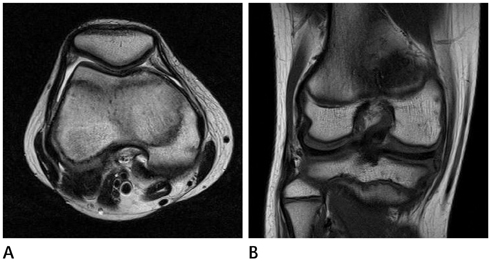J Korean Soc Radiol.
2013 Aug;69(2):149-152. 10.3348/jksr.2013.69.2.149.
Case Report of Imaging Analyses of the Dysplasia Epiphysealis Hemimelica (Trevor's Disease)
- Affiliations
-
- 1Department of Diagnostic Radiology, College of Medicine, Yeungnam University, Daegu, Korea. khcho@med.yu.ac.kr
- KMID: 2208819
- DOI: http://doi.org/10.3348/jksr.2013.69.2.149
Abstract
- Trevor's disease, also known as dysplasia epiphysealis hemimelica, is a rare developmental disorder presented with epiphyseal overgrowth involving one or multiple epiphyses. Here we report the radiologic findings of two cases of dysplasia epiphysealis hemimelica in a 4-year-old boy in the knee without symptom and a 10-year-old boy in the ankle with pain. The former was observed for eight years and the latter was treated with surgical resection.
MeSH Terms
Figure
Reference
-
1. Kuo RS, Bellemore MC, Monsell FP, Frawley K, Kozlowski K. Dysplasia epiphysealis hemimelica: clinical features and management. J Pediatr Orthop. 1998; 18:543–548.2. Shinozaki T, Ohfuchi T, Watanabe H, Aoki J, Fukuda T, Takagishi K. Dysplasia epiphysealis hemimelica of the proximal tibia showing epiphyseal osteochondroma in an adult. Clin Imaging. 1999; 23:168–171.3. Rosero VM, Kiss S, Terebessy T, Köllö K, Szöke G. Dysplasia epiphysealis hemimelica (Trevor's disease): 7 of our own cases and a review of the literature. Acta Orthop. 2007; 78:856–861.4. Tyler PA, Rajeswaran G, Saifuddin A. Imaging of dysplasia epiphysealis hemimelica (Trevor's disease). Clin Radiol. 2013; 68:415–421.5. Lang IM, Azouz EM. MRI appearances of dysplasia epiphysealis hemimelica of the knee. Skeletal Radiol. 1997; 26:226–229.6. Keret D, Spatz DK, Caro PA, Mason DE. Dysplasia epiphysealis hemimelica: diagnosis and treatment. J Pediatr Orthop. 1992; 12:365–372.






